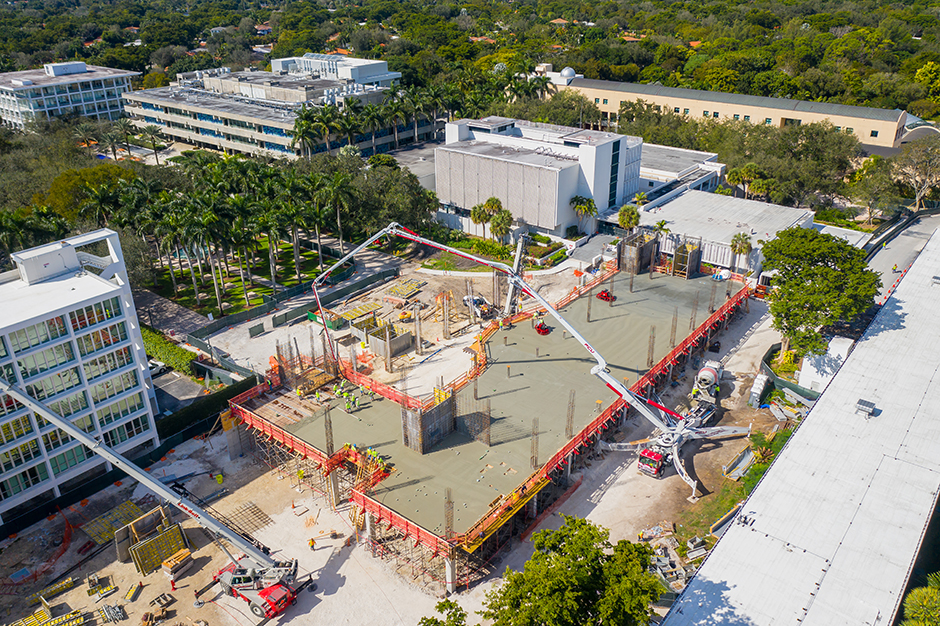Since arriving at the University of Miami a decade ago, Leonidas G. Bachas, dean of the College of Arts and Sciences, has dreamed of a research center where world-class chemists and molecular scientists could work with experts from other disciplines to tackle a myriad of global challenges, from clean water and disease to energy and food production.
Now, the analytical and biological chemist’s dream is literally becoming concrete. Recently, a convoy of trucks rumbled to the construction site of the Frost Institute of Chemistry and Molecular Science (FICMS) to deliver the 40 loads of concrete that now form the second-floor deck of the five-story wet-lab facility rising just east of the McLamore Fountain on Memorial Drive.
Following three years of planning and design, and months of site preparation, construction on the $60 million project—the first of a planned group of interdisciplinary research centers that will operate under the Frost Institutes for Science and Engineering umbrella—began last October and is moving apace to open in the summer of 2022. The highest floor deck, for a mechanical penthouse above the fifth floor, is slated to be poured this spring. Both the roof and the skin of the nearly 94,000-square-foot building, which will be encased in precast concrete and impact-resistant glass panels, is scheduled to be in place this fall.
“Completion is over a year away, but to watch the progress from my window is very gratifying,” said Bachas, interim director of both the FICMS and Frost Institutes umbrella, whose office in the Ashe Administration Building overlooks the construction site. “It is hard to overstate the role this building will play in moving discovery science forward. Not only will it help attract the kind of top scientists we are looking for—people who are creative, innovative, and infused with an interdisciplinary spirit—but it will attract graduate and undergraduate students for the opportunity to work in the labs of renown chemists and molecular researchers.”
A key initiative of the strategic Roadmap to Our New Century, the Frost Institutes took flight in 2017 when the University’s longtime benefactors, Phillip and Patricia Frost, announced a landmark $100 million gift to create a multidisciplinary research hub focused on scientific discovery. Jeffrey Duerk, the University’s executive vice president for academic affairs and provost, noted that the inaugural institute’s location underscores the importance of its mission.
“Chemistry and molecular science give rise to everything that we can see and touch, from the air we breathe, to our thoughts, to the objects we use daily—from our cells to our cellphones,” Duerk said. “From the emerging COVID vaccines to the microchips in our laptops, our lives are shaped by chemistry and molecular science. Because they are both central to so many fields and pervasive in their impact, it’s fitting that the first of the Frost Institutes is rising at the center of the Coral Gables campus, where it will propel the University’s trajectory as a leader in STEM research, education, and interdisciplinary discovery.”
Exactly what research will be pursued in the building, which initially will include 15,000-square-feet of wet-lab space on the third floor, will depend largely on the vision of the inaugural director, expected to be in place by this summer. For now, only one junior faculty member is on board, but there are plans to hire more than a dozen faculty members who will also teach across the University.
As such, Duerk, Bachas, and other members of the steering committee, who helped guide the FICMS’s design, have ensured that the L-shaped structure will have the flexibility to meet the needs of a multitude of interdisciplinary researchers now and in the future.
Designed by Harvard Jolly Architecture, a Florida firm with expertise in higher education, and constructed by Skanska, a global firm that built the award-winning Frost School of Music’s Patricia Louise Frost Studios, the FICMS has an open design, with moveable wet-lab benches and fixtures, allowing for the free flow of both ideas and people. The building is also designed to achieve, at the minimum, a silver rating from the Leadership in Energy and Environmental Design (LEED) green building certification program.
As the University’s research endeavors grow, the FICMS also will have room to expand. When the building opens, the fourth and fifth floors will remain empty shells. Eventually, each will accommodate another 15,000-square-feet of wet-lab space. The first floor will primarily be a public space, featuring a great hall and seminar rooms. But it also will have a microscopy imaging suite, where researchers can examine biological and other materials at the nanoscale.
And the second floor, the site of the building’s first major concrete pour, will house the director’s office and innovation labs, where faculty members from across the University can take up residence for an extended period to collaborate on synergistic research.
But Bachas is not waiting for the FICMS to inspire such collaborations. To date, the institute has awarded four seed grants to junior faculty members who teamed up with senior faculty members to pursue new research in molecular science that could lead to extramural grants and publications. Their topics include molecular systems for targeted drug delivery, tissue-like electrical conducting materials, the role of metals in the progression of neurodegenerative diseases, and the prediction of protein structure for drug design.

